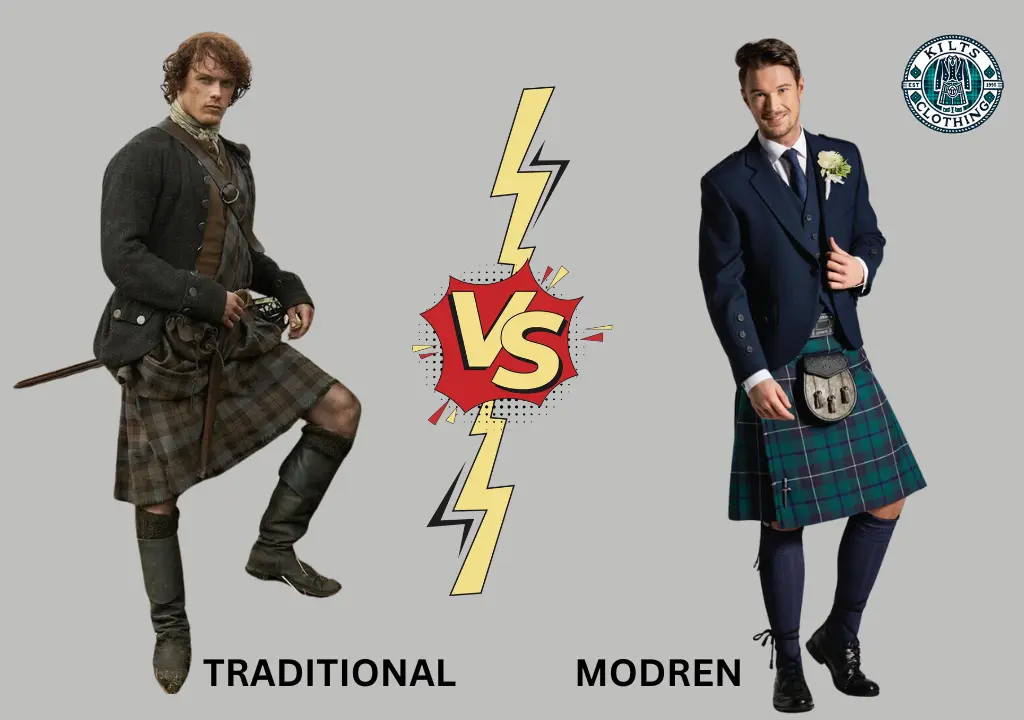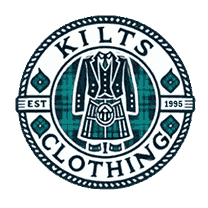Traditional Kilts vs. Modern Kilts: Unraveling the Fabric of History and Style

Kilts have long been symbolic of Scottish and Irish heritage, evolving from the rugged Highlands into modern fashion. Today, traditional and modern kilts represent two ends of a spectrum that reflects history and innovation. This article will explore these iconic garments, providing a kilt comparison highlighting their differences, cultural significance, and style evolution.
A Cultural Icon
Kilts are more than just clothing; they are a symbol of cultural identity and tradition. Whether you're donning a traditional kilt or a modern kilt, you're partaking in a legacy spanning centuries. This article delves into the fascinating world of kilts, examining their historical roots, design differences, and continued relevance in contemporary fashion.
The Historical Roots of Kilts
Origin of Traditional Kilts
The history of the kilt dates back to the late 16th century when the "belted plaid" or failed mor was first worn by Scottish Highlanders. These early kilt traditional were large pieces of cloth, often up to six yards long, wrapped around the body for warmth and protection. They were practical garments designed for the rugged Scottish terrain.
Evolution of Kilts Over the Centuries
As Scotland's cultural and social landscape evolved, so did the kilt. By the 18th century, the tartan kilts we recognize today had become a symbol of Scottish identity, particularly after the Jacobite uprisings. These uprisings, which were a series of rebellions against the British monarchy, led to the banning of kilts in an attempt to suppress Highland culture. However, after the ban was lifted, the kilt emerged as a symbol of national pride, reflecting the resilience and determination of the Scottish people.
The Role of Kilts in Scottish and Irish Culture
In Scottish and Irish cultures, kilts are more than just clothing—they symbolize heritage and identity. In Scotland, each tartan pattern is associated with specific clans, visually representing one's lineage. While kilts are less tied to specific clans in Ireland, they still hold cultural significance, particularly in military and ceremonial contexts. In Ireland, kilts are often associated with traditional music and dance, and they are also worn in formal occasions such as traditional irish wedding kilts and funerals.
Traditional Kilts:
Fabric and Weave:
Traditional kilts are typically made from wool, a fabric chosen for its durability, warmth, and traditional significance. The weave of the wool is crucial, often featuring a twill pattern that adds texture and depth to the fabric. The weight of the wool varies, with heavier kilts worn in colder climates and lighter ones in warmer weather.
Tartan Patterns:
The tartan patterns of traditional kilts are deeply symbolic, representing clans, families, and regions. Each pattern tells a story, with specific colors and arrangements denoting different heritage aspects. Wearing a traditional kilt with a clan tartan is a way of honoring one's ancestors and maintaining a connection to Scottish history.
Structure and Design:
The design of a traditional kilt is simple yet functional. It features pleats at the back and a flat apron at the front, secured by leather straps or buckles. The kilt's length typically falls just above the knee, providing both freedom of movement and a dignified appearance. This structure, unchanged for centuries, reflects the timeless nature of the garment, connecting the wearer to a rich cultural heritage.
Symbolism and Cultural Significance
Traditional kilts are worn during important cultural events, such as weddings, funerals, and Highland games. They serve as a powerful symbol of Scottish and Irish identity, representing not just the wearer but also their family, clan, and heritage. Wearing a traditional kilt is often seen as a gesture of respect and pride in one's roots.
Modern Kilts:
Utility Kilts:
In contrast to their traditional counterparts, modern kilts—particularly utility kilts—are designed with practicality in mind. These kilts often feature pockets, loops, and even modern materials like denim or canvas, making them suitable for everyday wear. Utility kilts are popular among those who appreciate the kilt's heritage but desire a more functional garment for contemporary life.
Fabric Innovations:
While wool remains a popular choice for modern kilts, many now incorporate synthetic fabrics like polyester or cotton blends. These materials offer increased durability, ease of care, and a wider range of colors and patterns. This shift reflects the changing needs of kilt wearers seeking tradition and convenience.
Design Variations:
Modern kilts often feature design elements that cater to the needs of today's wearers. Pockets, adjustable straps, and even detachable pouches are common, offering style and functionality. These variations allow the kilt to be worn in a variety of settings, from casual outings to more formal events, without sacrificing comfort or practicality.
Modern Kilts in Fashion:
Modern kilts have found a place in contemporary fashion, with designers incorporating them into both casual and formal wear. Whether paired with a t-shirt for a laid-back look or a tailored jacket for a more formal occasion, these kilts offer versatility and a unique way to express personal style. Blending traditional and modern elements makes the modern kilt a dynamic addition to any wardrobe.
Key Differences Between Traditional and Modern Kilts
Material Choices:
The most significant difference between traditional and modern kilts lies in the materials used. Traditional kilts are made from wool, a fabric with deep historical roots, while modern kilts may use various materials, including synthetic fibers, that offer different benefits.
Design Elements:
The design of traditional kilts focuses on simplicity and historical accuracy, with wrinkles, aprons, and minimal accessories. On the other hand, modern kilts often incorporate additional features like pockets and adjustable straps, making them more suited to contemporary lifestyles.
Manufacturing Processes:
Traditional kilts are often handmade, with each pleat carefully crafted to maintain the integrity of the tartan pattern. Modern kilts may be produced using advanced manufacturing techniques, allowing for greater customization and variety in design.
Cultural Perception and Usage:
While traditional kilts are often reserved for formal occasions, modern kilts have become everyday wear. This shift reflects broader changes in cultural attitudes, with the kilt becoming a symbol of tradition and modernity.
Cultural and Symbolic Significance
Traditional Kilts:
Traditional kilts are closely tied to Scottish and Irish heritage, symbolizing clan identity and cultural pride. Wearing these kilts during important events is a way of honoring one's ancestors and maintaining a connection to history.
Modern Kilts:
Modern kilts have expanded beyond their traditional roots to become a global fashion statement. They are worn by people from various backgrounds who appreciate their unique blend of tradition and modernity. This global appeal has helped to keep the kilt relevant in contemporary society.
Occasions for Wearing Kilts
When to Wear a Traditional Kilt
Traditional kilts are typically worn during formal events such as weddings, funerals, and cultural festivals. They add a touch of elegance and a strong sense of cultural identity to any occasion, making them the preferred choice for those looking to honor their heritage.
Modern Kilts for Everyday and Special Occasions
Modern kilts are versatile garments that can be worn in both casual and formal settings. Their practical design and contemporary appeal make them suitable for everyday wear and special occasions where a more relaxed dress code is acceptable.
How to Choose Between a Traditional and Modern Kilt
Considerations for Formal Events
When choosing a kilt for a formal event, it's important to consider the occasion and your cultural ties. A traditional kilt with a clan tartan pattern is often the best choice for weddings, funerals, or other events steeped in heritage.
Practicality and Comfort for Daily Wear
A modern utility kilt may be more practical for everyday wear. These kilts offer the comfort and functionality needed for daily activities while maintaining a connection to traditional Scottish attire.
Styling Tips for Both Traditional and Modern Kilts

Traditional Kilt Accessories:
Accessories are key to completing the look of a traditional kilt. Items like the sporran, kilt hose, and ghillie brogues are essential components that add to the outfit's overall appearance and cultural significance.
Modern Kilt Accessories:
Modern kilts offer more flexibility in accessories. Depending on the occasion, you can pair them with casual or formal belts, sporrans, and even boots or sneakers. This versatility allows for various styling options tailored to personal preferences.
Care and Maintenance of Kilts
Preserving Traditional Wool Kilts
Proper care is essential to preserve the quality of a traditional kilt. Wool kilts should be dry-cleaned and stored in a cool, dry place to prevent damage to the fabric and maintain the tartan patterns.
Maintaining Modern Utility Kilts
Depending on the materials used, modern kilts may be easier to care for. Many can be machine washed, though it's important to follow the manufacturer's care instructions to ensure they remain in good condition.
Conclusion
Traditional and modern kilts hold significant value, each serving distinct purposes while preserving the cultural essence of their origins. Traditional kilts remain a powerful symbol of heritage, often worn during formal events to honor Scottish and Irish ancestry. They embody the rich history of the clans and the regions they represent, with their tartan patterns and woolen fabrics integral to their timeless appeal.
On the other hand, modern kilts offer a contemporary take on this iconic garment, blending functionality with tradition. They cater to the needs of today's wearers, providing comfort and versatility while maintaining a nod to their historical roots. Whether you choose a traditional kilt for its cultural significance or a modern kilt for its practicality and style, both garments continue to be cherished symbols of identity and personal expression in the modern world.
FAQs
Traditional kilts are made from wool and feature specific tartan patterns associated with clans or regions, emphasizing cultural heritage. They are usually worn during formal events. On the other hand, modern kilts may use various materials, including synthetic fabrics, and often include practical features like pockets and adjustable straps, making them suitable for everyday wear.
Yes, modern kilts can be worn for formal occasions, but choosing one that maintains a level of sophistication appropriate for the event is essential. Pairing a modern kilt with traditional accessories like a sporran or kilt hose can help create a more formal look while embracing contemporary style.
To preserve a traditional wool kilt, it’s recommended that it be dry cleaned and stored in a cool, dry place. Avoid hanging the kilt for long periods, which can distort the pleats. Using a kilt storage bag can help protect the fabric from dust and moths.
Traditional kilts are often preferred for culturally significant events, such as weddings, funerals, and Highland games. They are also worn during national celebrations like Burns Night in Scotland, where the kilt symbolizes Scottish heritage.
Traditional kilts require accessories like the sporran, kilt hose, ghillie brogues, and a kilt pin. Modern kilts offer more versatility, allowing you to pair them with belts, sporrans, and even contemporary footwear like boots or sneakers, depending on the occasion.




